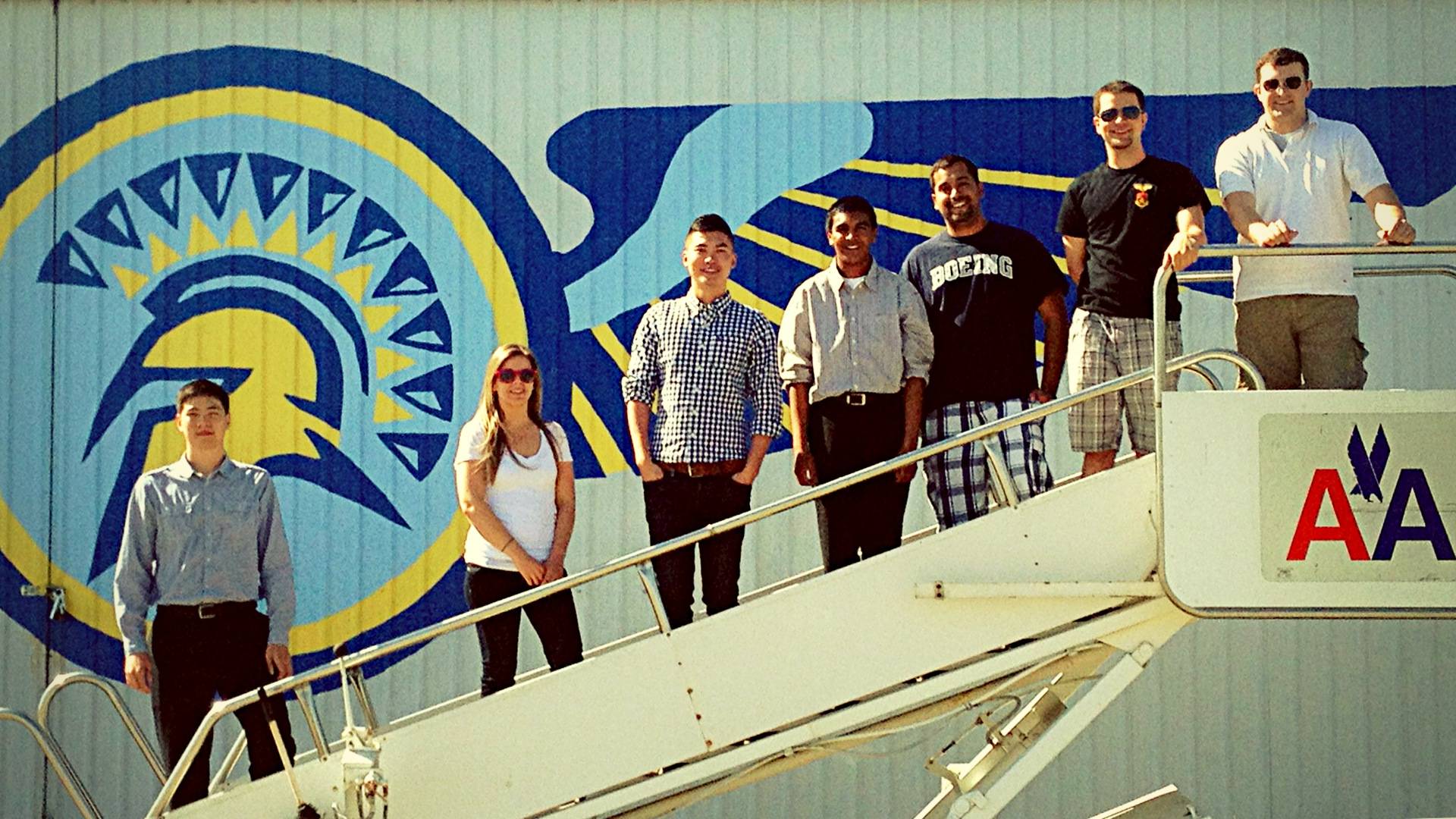Aviation Students Gain National Recognition for Unique Project Using Human Urine for Electrical Power
Imagine that you could use human urine as an alternative to electrical power production at your local airport and as a result, you lower the costs associated with operating the airport at maximum efficiency while benefiting the environment at the same time?
 Aviation students at Reid-Hillview Airport, SJSU’s aviation facility. From left to
right: Jason Soo, Heidi Cox, Xingjian Zhou, Cameron Singh (TA for capstone class and
project), Luis Torres, Kevin Kerlan, Tommy Ondrasek.
Aviation students at Reid-Hillview Airport, SJSU’s aviation facility. From left to
right: Jason Soo, Heidi Cox, Xingjian Zhou, Cameron Singh (TA for capstone class and
project), Luis Torres, Kevin Kerlan, Tommy Ondrasek.
The idea is not as far-fetched as it might sound. A 12-member aviation student team
(all seniors) along with their advisor, Professor Glynn Falcon, tackled that very
issue. They entered their project, aptly named The Power of Urine, in the seventh
annual Design Competition for Universities, sponsored by the Federal Aviation Administration
(FAA), the Department of Transportation agency responsible for the safety of civil
aviation. The small but mighty SJSU team competed with the brightest and best from
major U.S. universities. The FAA praised the team for their efforts - and gave it
an Honorable Mention in the competition.
"It was gratifying to see these students come together and coalesce into a fully-functioning project team," says Professor Falcon. "Even more amazing, they had less than eight weeks to innovate, research, collaborate, and then actuate their project into a professional report by the submission deadline. Typically, most universities begin their projects some eight months before the deadline at the start of fall semester.
"Aviators have always been lauded for their 'can-do' spirit, our students are 'true Aviators,'" says Falcon.
The project idea originated with team member Heidi Cox who explains her inspiration, "I'd read an article about some young girls in Nigeria who successfully created a urine-powered generator to produce electricity for their homes (mostly light bulbs)," she recalls. "After some general research, I discovered that the idea has been around for quite some time, but on a much smaller scale - like using human urine to power hearing aids and small batteries.
"Since the project needed to be 'green,' we used the same concept, but with a different method applied to the aviation industry," continues Cox. "We spoke to chemists, engineers, people in the operations department at San Jose International Airport, and even electricians. It took considerable research to gain the knowledge needed to create a device that could generate enough electricity."
Challenges to overcome
"trying to find information on the urine generator process itself," says Cox. "There were a few different ways to accomplish the process, but we wanted the most efficient method. It was also difficult trying to get team members together at one time, since there were 12 of us and we all had different schedules."
"figuring out how the chemistry worked, how the electricity was produced, and understanding all the electrical setups to implement it," says Megan Bringham. "We also had ideas about what we should use the electricity for; however, after speaking with an operations employee at KSJC, we realized our original ideas wouldn’t work," laments Bringham. "We hit wall after wall, but were determined to find a solution."
Adds Kevin Kerlan, "trying to understand material we weren’t well versed in posed a challenge. Since we are all aviation majors, you would think it would be right up our alley. When speaking with outside experts, it wasn’t always easy trying to explain what we needed help with, but we were persistent," he says.
"there were only a few local experts who could offer really useful information," Tommy Ondrasek says. "The next challenge was to get interviews with them."
All worth it
"While we didn't win the competition in our category, getting honorable mention rewarded us for our hard work," says Ondrasek. "I’m very fortunate to have worked on such a challenging project. While it doesn’t directly relate to my chosen career as a professional pilot, it has broadened my outlook on the industry. We were able to work on an innovative project that could one day change the world."
"The project was difficult and frustrating at times, but every second was worth it," says Bringham. "We gained great experience and knowledge and I'm thrilled we placed honorable mention! This department has helped me excel in and outside of the classroom."
"For me, says Kerlan, "it was surreal because gaining national attention for our small aviation department doesn’t happen often. It’s that great spirit within our department that brought us together to create something significant. I also credit Professor Falcon for his enthusiasm that kept us motivated."
Seth Bates, chair of the Department of Aviation and Technology, is also proud of what these students have accomplished. "Continuing engagement in the FAA competition under the direction of our faculty has been beneficial to our students and our aviation program," he says. "Our students and faculty have brought national awareness and recognition for SJSU, and our teams consistently place well and often win awards.
"This year’s team, in particular, deserves special recognition for their gumption
and creativity!" enthuses Bates.
To read the original article, visit :